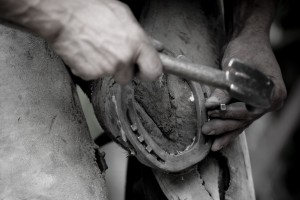Thrush is an infection with an anaerobic bacterium found in the horse’s environment.
Thrush is usually identifiable by a strong putrid odor accompanied by a thick black liquid in the horse’s frog, specifically in the sulci.
It’s easy to understand how horses get thrush when you consider most horses get turned out in the same paddocks – day in and day out. Manure and urine are accumulated over many years and are layered into the ground. This makes paddocks a breeding ground for many opportunistic bacteria and fungi which is the main contributor to thrush.
Dirty stalls are the other obvious breeding environment.
Unfortunately, thrush can become chronic, and there are two main factors contributing to the development and persistence of thrush:
- Poor foot confirmation
- The horse’s individual susceptibility to it.

A horse with a very narrow upright heel is more likely to get thrush because; the frog doesn’t interact with the ground as it should. The frog of a horse is subject to the old “Use it or lose it” motto, just as any muscle would be. The frog is part of the hydrodynamic system of the foot (i.e. the circulatory system) the foot loading and unloading on the ground, increases circulation which is part of the circulatory process. When the frog is too high up within the hoof-capsule, the fogs interaction with the ground is limited. With limited stimulation from the ground, the frog atrophies. This results in the acquisition of, and difficulty in— treating thrush.
If your horse has chronic thrush and nothing you’ve tried has worked, here are some suggestions:
- Stay away from pads. They create an anaerobic environment which proliferates thrush and white lines disease.
- Pick the feet and brush out the frog area at least once daily. You can treat the thrush with your choice of medication; what’s more important is the consistency of cleaning and treatment.
- If your horse lives outside permanently with other horses in a wet paddock, before you go riding.
- If your horse is turned out during the day but comes into a clean stall at night, treat the thrush before he goes in the stall for the evening.
In both cases, the goal is to have medication working as long as possible.
When thrush has created a large cavity in the central sulcus (or collateral sulci) lameness, or sensitivity of the frog often manifests. If lameness or sensitivity is indicated, you need to do two important things: clean and pack the area. Before you pack the cavity, take some cotton swabs and run them through the cavity. Do this repeatedly until the swabs come out clean. Then pack the cavity carefully with cotton, then soak the cotton with medication.
This benefits the horse in two ways: one, it will keep the infection medicated, and two, it will help keep out the mud, dirt, and manure that have all the anaerobes in it.

Your choice of medication is important when; the thrush has eaten into the sensitive tissue, you don’t want a medication that is caustic. Horses tend to resent being burned every day by medication. That is why some people use Hedison K. I recommend Today (cephapirin sodium), or Tomorrow (cephapirin benzathine) because they have been proven to be very effective.
Both the Farrier and Veterinarian have important roles in treating thrush. It is often the Farrier who discovers the infection while removing the shoes and pads.
Sometimes infections of the frog look superficial and that is why the owner (or groom) might not be alarmed. There are times when it can look that way to the Farrier as well.
The Farrier knows that the infection has reached sensitive tissue when the cleaning and trimming activity causes blood to manifest. This usually means the bacteria has created a cavity under the surface of the frog and cannot be seen by just looking at the bottom of the hoof. In that situation, the Farrier will have to debride all the necrotic tissue that can be removed without doing surgery –which is obviously the vet’s domain. If the situation gets that far, the vet will remove the deeply infected tissue, bandage the foot with medication, prescribe antibiotics and confine the horse to a clean environment.
Your job, as the owner is to insure this does not happen. The most important role in taking care of thrush is on the caretaker’s shoulders. Simply put, without daily care, the situation cannot be resolved.
Notes: The causative organism(s) for thrush are, fusobacterium, necrophorum. The causative organism(s) of hoof wall disease (aka, white line disease, seedy toe) is fungal onchonmycosis).
